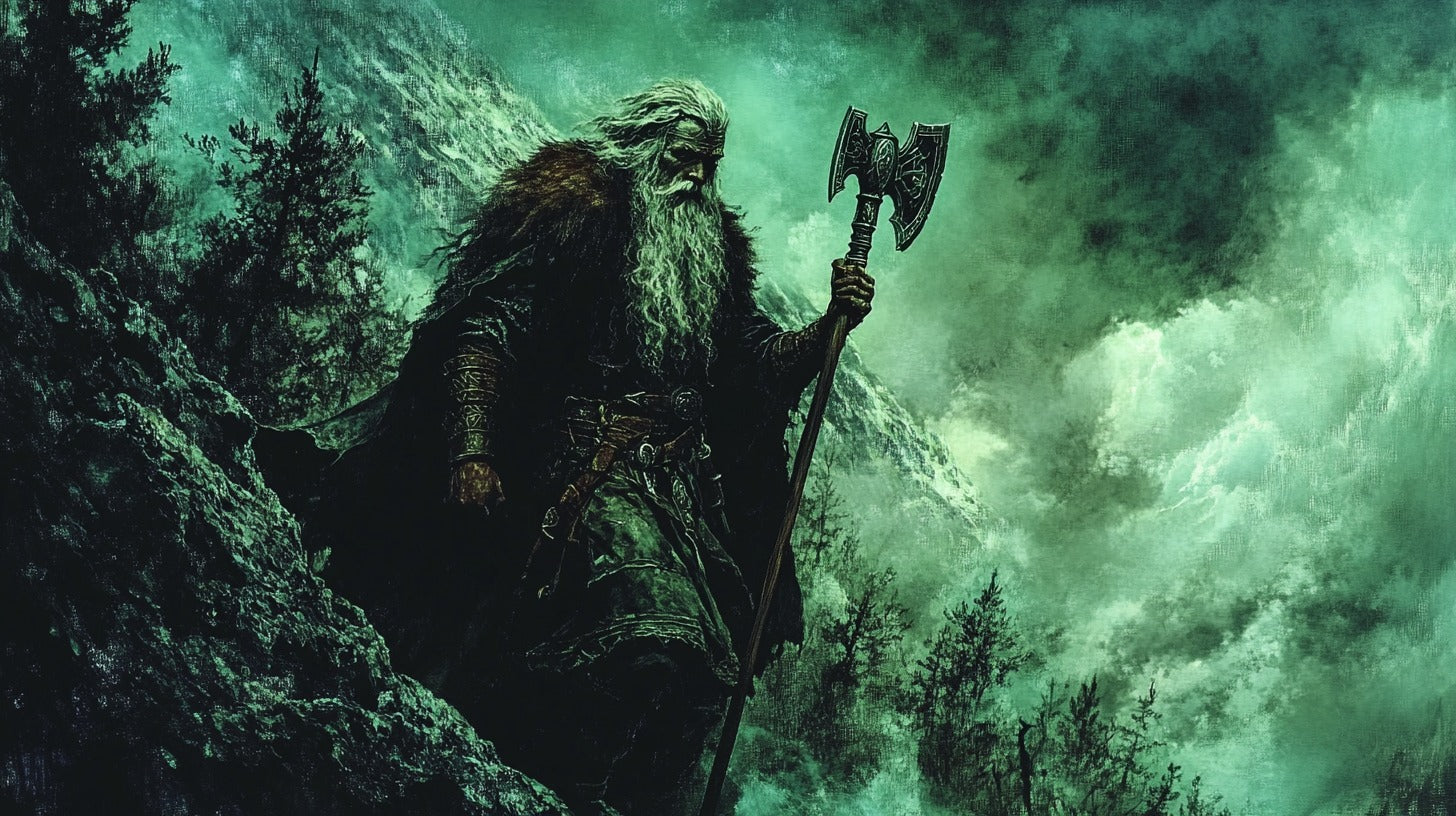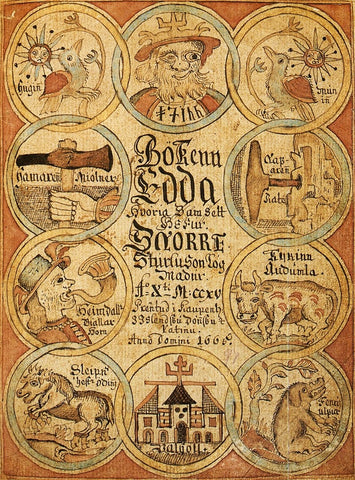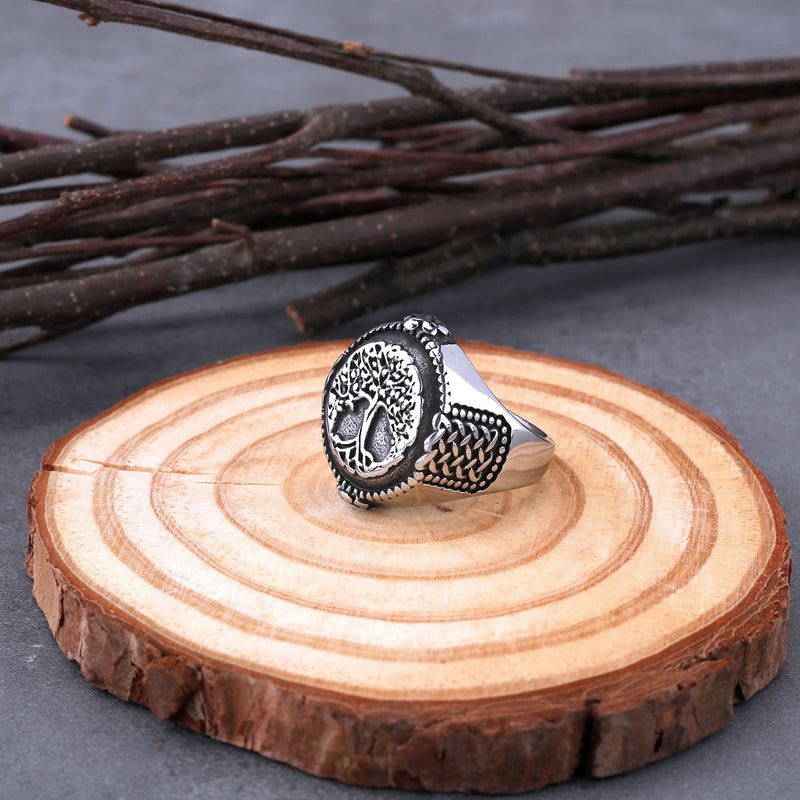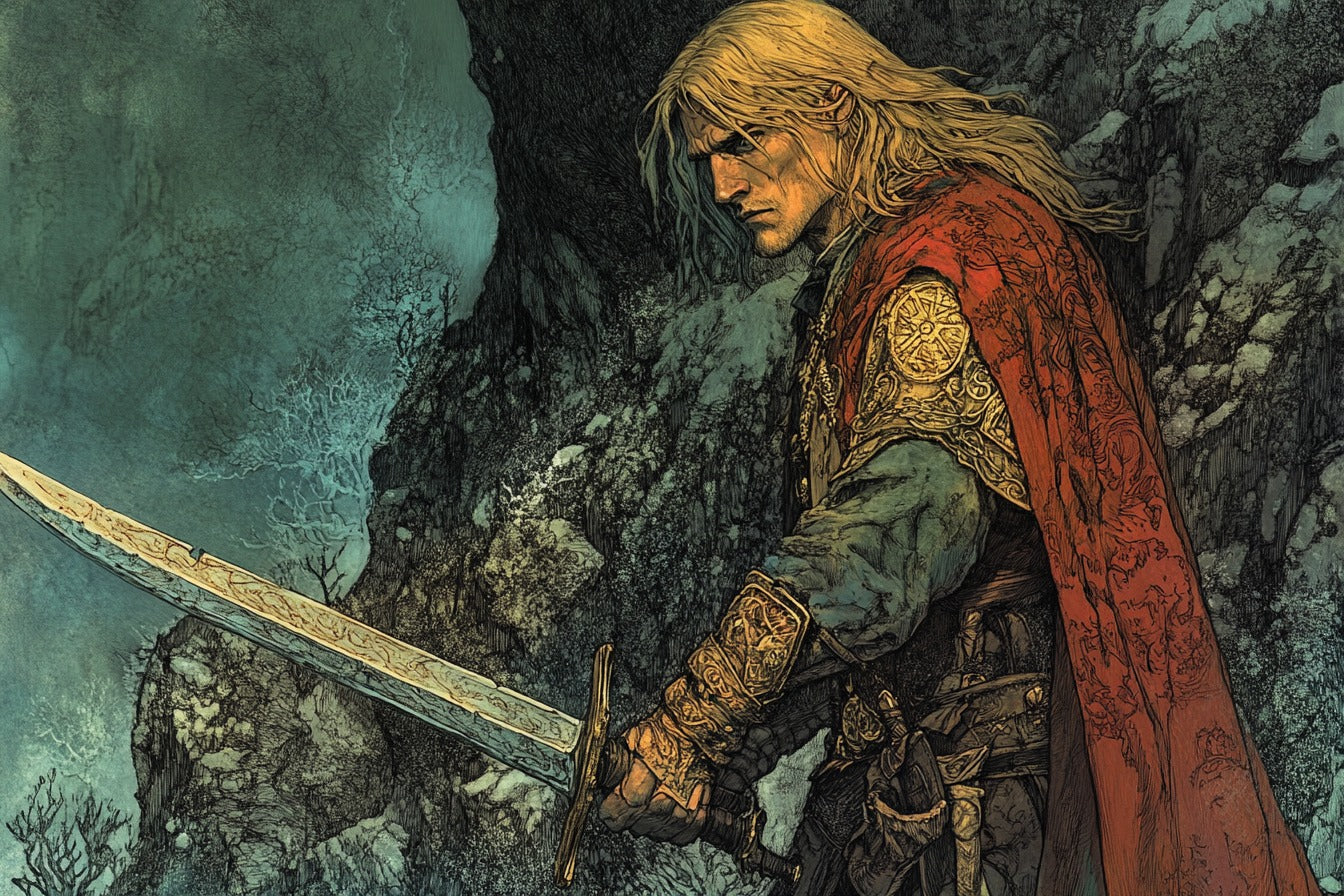
A Comprehensive Guide to Norse Mythology
In 1643, an unassuming Icelandic farmer unearthed a weathered manuscript that would change our understanding of Norse mythology forever. This document, part of what we now call the Poetic Edda, opened a window into a world of complex deities, cosmic battles, and prophesied doom. As we delve into the realm of Norse myths, we'll trace the journey of these stories from ancient oral traditions to carefully preserved texts, and examine how they've shaped our modern understanding of Viking culture..
The Origins of Norse Mythology

Cover of the Prose Edda written by Snorri Sturluson (13th century), showing the Ancient Norse Gods Odin, Heimdallr, Sleipnir, and other figures from Norse mythology
The Proto-Norse Period
Long before the Vikings set sail in their dragon-prowed longships, the seeds of Norse mythology were already taking root in the frozen soil of Northern Europe. The Proto-Norse period, shrouded in the mists of time, saw the first whispers of the gods who would one day dominate the Norse pantheon.
In those ancient days, when the world was young and the stars were new, our ancestors huddled around fires, their eyes wide with wonder as they gazed upon the natural world. They saw patterns in the chaos, meaning in the meaningless, and slowly, like a tapestry being woven by unseen hands, the first stories began to take shape.
The Viking Age and Its Influence
But it was during the Viking Age, that tumultuous period of exploration, conquest, and cultural exchange, that Norse mythology truly came into its own. As Norse raiders and traders ventured forth into the wider world, they brought with them their stories and beliefs, and in turn, were influenced by the cultures they encountered.
Picture a Viking longship cutting through the fog-laden waters of the North Sea. On board, grizzled warriors swap tales of Odin's wisdom and Thor's might, their words carried away by the salty breeze. With each journey, with each new land discovered, the mythology grew richer, more complex, a living, breathing entity that evolved with the people who created it.
The Norse Cosmos: The Nine Worlds
At the heart of Norse mythology lies a cosmology as intricate and interconnected as the roots of Yggdrasil, the world tree. Nine worlds, each distinct yet inextricably linked, form the backdrop against which the great dramas of the gods and monsters play out.

Asgard: Realm of the Aesir
High above, nestled among the clouds and stars, lies Asgard, the shining citadel of the Aesir gods. Its golden halls gleam in the eternal sunlight, a beacon of power and majesty. Here, in Valhalla, Odin hosts the fallen warriors, preparing for the final battle at the end of days.
Can you hear the laughter echoing from the feast halls? Can you see the Valkyries swooping through the sky, bearing the souls of the worthy to their final reward? Asgard stands as a testament to the Norse ideal of glory and honor, a place where the brave find their ultimate purpose.
Midgard: The World of Humans
Beneath Asgard, connected by the rainbow bridge Bifrost, lies Midgard, the realm of humans. Our world, a place of both beauty and hardship, joy and sorrow. The Norse saw Midgard as a place of constant struggle, where humans must prove their worth in the eyes of the gods.
Look around you. The very earth beneath your feet, the sky above your head, all of it is Midgard. In Norse mythology, our world is not separate from the realm of the divine, but an integral part of it. The gods walk among us, unseen perhaps, but ever-present.
Jotunheim: Land of the Giants
And what of Jotunheim, the wild and untamed land of the giants? A place of primal forces and ancient magics, where the Jotnar, those elemental beings of incredible power, make their home. Jotunheim represents the chaotic, uncontrollable aspects of nature, a constant threat to the order imposed by the Aesir.
The Perpetual Conflict Between Gods and Giants
The enmity between the Aesir and the Jotnar is the stuff of legend. Tales abound of Thor's battles with giant-kind, of Odin's cunning tricks to outwit them. Yet, this conflict is not as black and white as it might first appear. The gods themselves often have giant blood, and many of their greatest allies (and enemies) come from Jotunheim.
In this eternal struggle, we see reflected our own battles against the wild, untamed aspects of nature and ourselves. The giants represent not just physical threats, but the primal, chaotic forces that lurk within the human heart.
The Major Norse Gods and Goddesses

Odin: The All-Father
At the head of the Norse pantheon stands Odin, the All-Father, god of wisdom, war, and death. One-eyed and all-seeing, Odin's quest for knowledge knows no bounds. He hung himself from Yggdrasil for nine days and nights to gain the wisdom of the runes, sacrificed an eye to drink from Mimir's well of knowledge, and sends his ravens, Huginn and Muninn (Thought and Memory), to fly across the world each day, bringing him news of all that transpires.
Odin is a complex figure, embodying both the noble pursuit of wisdom and the ruthless cunning required to rule. He is the patron of kings and poets alike, a god as comfortable in the halls of power as he is on the battlefield.
Thor: God of Thunder
If Odin is the brain of the Norse pantheon, then Thor is surely its beating heart. God of thunder, protector of Midgard, Thor's mighty hammer Mjolnir is the bane of giants and the shield of humankind. His red beard and booming laugh are as iconic as the lightning bolts he hurls from the storm-wracked sky.
Thor represents the ideal Norse warrior - strong, brave, and fiercely loyal. But he's not just a brute force. Thor's adventures often showcase his quick wit and problem-solving skills, reminding us that true strength lies in more than just muscle.

Skåne Mjölnir Thor's Hammer Replica Bracelet
Freya: Goddess of Love and War
And what of Freya, the most renowned of the Vanir gods? Goddess of love, beauty, and war, Freya embodies the dual nature of passion - its ability to create and destroy in equal measure. She rides into battle in a chariot pulled by cats, wears a cloak of falcon feathers that allows her to fly between worlds, and weeps tears of red gold.
Freya reminds us of the complexity of the Norse gods. She is not just a love goddess, but a fierce warrior in her own right. In her, we see the Norse ideal of the complete person - someone equally at home in the bower and on the battlefield.
Legendary Creatures and Beings

Mímer and Balder Consulting the Norns (1821-1822) by H. E. Freund / Photo: Bloodofox
The Norns: Weavers of Fate
Deep beneath the roots of Yggdrasil dwell the Norns, those inscrutable weavers of fate. Urd (What Once Was), Verdandi (What Is Coming into Being), and Skuld (What Shall Be) tend the world tree and weave the tapestry of destiny for gods and mortals alike.
The concept of fate looms large in Norse mythology. Even the gods are not immune to its decrees. The Norns remind us of the inevitability of destiny, yet also of our power to shape our own stories within the framework they provide.
Valkyries: Choosers of the Slain
Soaring above the battlefields on their winged steeds, the Valkyries are perhaps some of the most iconic figures in Norse mythology. These warrior maidens, chosen by Odin himself, select which of the fallen are worthy to join the ranks of the Einherjar in Valhalla.
The Valkyries embody the Norse attitude towards death in battle - not something to be feared, but an opportunity for glory and a chance at eternal reward. They bridge the gap between the mortal world and the divine, serving as both harbingers of doom and bearers of ultimate honor.
Epic Tales and Sagas

The Creation Myth
In the beginning, there was only the yawning void of Ginnungagap. From the interplay of ice and fire came the first beings - Ymir, the primordial giant, and Audhumla, the cosmic cow. From Ymir's body, Odin and his brothers crafted the world, using his flesh for the earth, his blood for the seas, his bones for the mountains, and his skull for the dome of the sky.
This creation myth speaks to the Norse view of the universe as a place of constant struggle and change. Even the world itself was born from violence, setting the stage for the conflicts to come.
Ragnarök: The Twilight of the Gods
And what of the end? For in Norse mythology, even the gods must face their doom. Ragnarök, the twilight of the gods, looms ever on the horizon. A time when the bonds of kinship will break, when brother will fight brother, and the forces of chaos will overtake the nine worlds.
Yet, even in this bleakest of prophecies, there is hope. For after the destruction, a new world will arise from the ashes of the old, green and fair. The cycle begins anew, reminding us that even in the face of inevitable doom, life finds a way to persevere.
Norse Mythology in Modern Culture

Literature and Art
The influence of Norse mythology extends far beyond the fjords of Scandinavia. From Wagner's epic "Ring Cycle" to Tolkien's "Lord of the Rings," the fingerprints of the Norse gods can be found all over modern literature and art. The raw power and primal nature of these myths continue to inspire creators to this day.
Movies and Television
In recent years, we've seen a resurgence of interest in Norse mythology in popular culture. From the Marvel Cinematic Universe's portrayal of Thor and Loki to the hit TV series "Vikings," these ancient tales are finding new life on the silver screen. While often taking liberties with the source material, these adaptations have introduced a whole new generation to the wonders of Norse mythology.
Conclusion
As our journey through the Nine Worlds comes to an end, we find ourselves back in Midgard, our own realm. Yet, are we truly the same as when we began? The tales of the Norse gods, with their complex personalities and all-too-human flaws, hold up a mirror to our own society. They remind us of the power of storytelling, the importance of honor and wisdom, and the eternal struggle between order and chaos.
Norse mythology, with its rich tapestry of gods, giants, and legendary creatures, continues to captivate us because it speaks to something deep within the human psyche. It offers us a way to understand the natural world, to grapple with the big questions of existence, and to find meaning in the face of an often harsh and unforgiving universe.
As you go forth from here, remember the lessons of the Norse myths. Be brave like Thor, seek wisdom like Odin, embrace passion like Freya. For in the end, are we not all writing our own sagas, weaving our own fates in the great tapestry of existence?
FAQs
- Who are the main gods in Norse mythology?
The main gods in Norse mythology include Odin (the All-Father), Thor (god of thunder), Freya (goddess of love and war), Loki (the trickster god), Baldur (god of light and purity), and Tyr (god of law and justice).
- What is Yggdrasil in Norse mythology?
Yggdrasil is the world tree in Norse mythology, a giant ash tree that connects the Nine Worlds. It is considered the cosmic axis of the Norse universe.
- What is Ragnarök?
Ragnarök, often translated as "Twilight of the Gods," is the Norse apocalypse. It's a series of future events including a great battle foretold to ultimately result in the death of many gods, natural disasters, and the submersion of the world in water.
- How does Norse mythology compare to Greek mythology?
While both mythologies have complex pantheons and epic tales, Norse mythology tends to be darker and more fatalistic. The Norse gods are mortal and destined to die at Ragnarök, unlike the immortal Greek gods. Norse myths also place more emphasis on the conflict between order and chaos.
- How has Norse mythology influenced modern popular culture?
Norse mythology has greatly influenced modern culture, particularly in literature, art, and entertainment. It has inspired works ranging from Wagner's operas to Marvel's Thor comics and movies. Elements of Norse mythology can be found in many fantasy novels, games, and TV shows.
References
Gaiman, N. (2017). Norse Mythology. W. W. Norton & Company.
Larrington, C. (2017). The Norse Myths: A Guide to the Gods and Heroes. Thames & Hudson.
Crossley-Holland, K. (2018). Norse Myths: Tales of Odin, Thor and Loki. Candlewick Press.
McCoy, D. (2016). The Viking Spirit: An Introduction to Norse Mythology and Religion. CreateSpace Independent Publishing Platform.
Lindow, J. (2001). Norse Mythology: A Guide to the Gods, Heroes, Rituals, and Beliefs. Oxford University Press.








